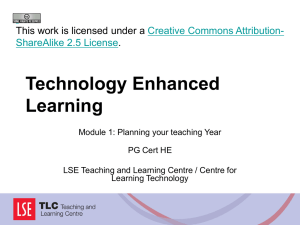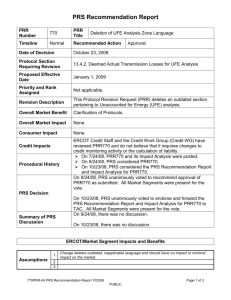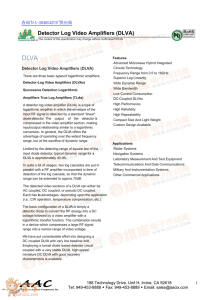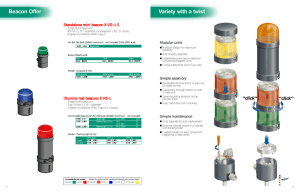LSE_example of embedding IL and DL
advertisement
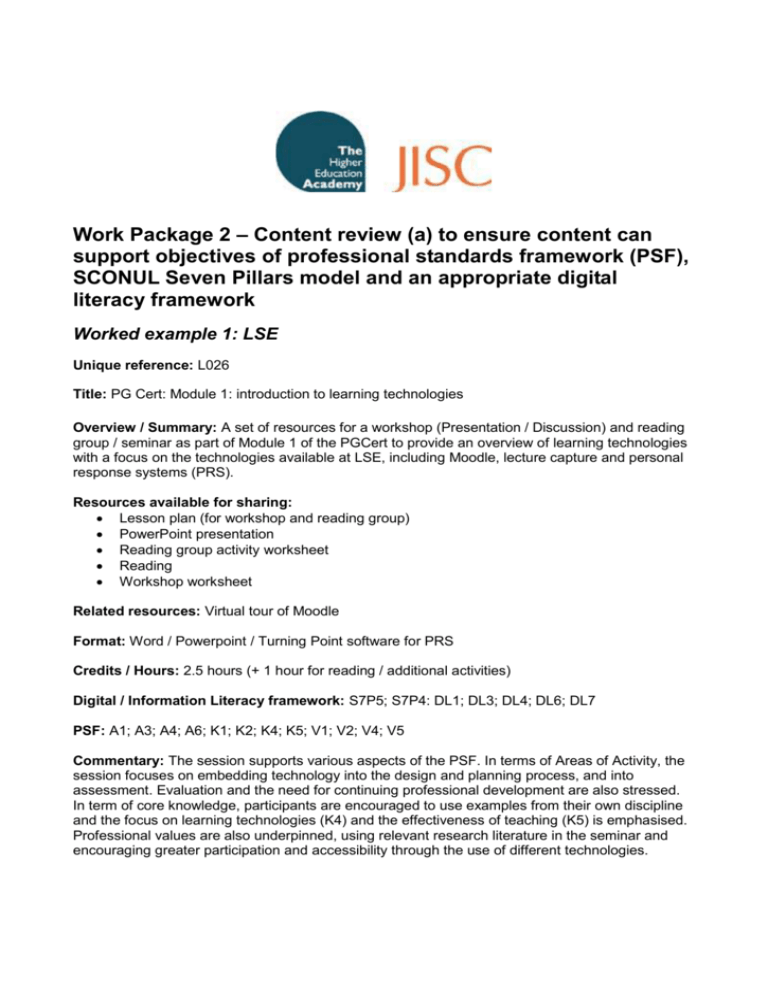
Work Package 2 – Content review (a) to ensure content can support objectives of professional standards framework (PSF), SCONUL Seven Pillars model and an appropriate digital literacy framework Worked example 1: LSE Unique reference: L026 Title: PG Cert: Module 1: introduction to learning technologies Overview / Summary: A set of resources for a workshop (Presentation / Discussion) and reading group / seminar as part of Module 1 of the PGCert to provide an overview of learning technologies with a focus on the technologies available at LSE, including Moodle, lecture capture and personal response systems (PRS). Resources available for sharing: Lesson plan (for workshop and reading group) PowerPoint presentation Reading group activity worksheet Reading Workshop worksheet Related resources: Virtual tour of Moodle Format: Word / Powerpoint / Turning Point software for PRS Credits / Hours: 2.5 hours (+ 1 hour for reading / additional activities) Digital / Information Literacy framework: S7P5; S7P4: DL1; DL3; DL4; DL6; DL7 PSF: A1; A3; A4; A6; K1; K2; K4; K5; V1; V2; V4; V5 Commentary: The session supports various aspects of the PSF. In terms of Areas of Activity, the session focuses on embedding technology into the design and planning process, and into assessment. Evaluation and the need for continuing professional development are also stressed. In term of core knowledge, participants are encouraged to use examples from their own discipline and the focus on learning technologies (K4) and the effectiveness of teaching (K5) is emphasised. Professional values are also underpinned, using relevant research literature in the seminar and encouraging greater participation and accessibility through the use of different technologies. Lesson plan with examples of integration of DL / IL Module title: Module 1: Planning your teaching year Module learning outcomes: By the end of this module participants will be able to: critically reflect on good practice in teaching and learning within their disciplinary context design and implement appropriate teaching delivery and learning support strategies in a range of different learning contexts outline the role learning technologies do, or could, play in supporting their teaching practice and student learning synthesise and make use of the relevant pedagogical literature in relation to their own practice Session title: Introduction to learning technologies Structure: 1 hour reading group / seminar followed by 1.5 hour workshop. Students are encouraged to attend both sessions but they are optional. Session learning outcomes: By the end of this session participants will be able to: Critically reflect on good practice in teaching and learning using technology at LSE outline the role learning technologies do, or could, play in supporting their teaching practice and student learning design and implement a teaching session using technologies as appropriate Timing: Week 6, Michaelmas Term. Resources (virtual tour) available from week 1. Students have already attended two sessions to give them an overview of planning their teaching Resources Virtual tour of best practice of using Moodle at LSE PRS equipment PRS quiz Hand-out / worksheets Seminar / reading group Week 6: Michaelmas Term Session overview PowerPoint used to structure session and introduce key concepts. The entire session could be described as digital literacy. However, it includes specific elements of information literacy (S7P4 and S7P5) which are highlighted in red below. 1) Technology Enhanced Learning DL1; DL3; DL7 Activity – Worksheet to prompt discussion – individually -- answer the following three questions: (i) What learning technologies have you used before in your teaching and learning? (Give three examples) (ii) Give an example of how a technology enhanced your teaching and learning. (iii) How do you plan to use learning technology in your coming years? . Group discussion – leading into a broader discussion of why use learning technologies? (see below) 2) Definitions and introduction to the use of technology to define terms such as: DL1; DL3; DL4; S7P5 Why use it (briefly as discussed in reading group) – How technology is not a bolt on but part of everything we do and should form an integral part of planning our teaching E-learning / online learning / blended learning / distance learning (include these words on worksheet). In pairs come up with definitions for these different forms of learning. 3) Learning Technologies at LSE DL1; DL3; DL4 Revisiting the virtual tour of moodle and overview of learning technologies – how these facilitate teaching and learning. Technologies inside and outside the classroom – elicit examples, mention lecture capture as example of technology bridging gap inside and outside the classroom Flag up relevant courses offered by Centre for Learning Technology 4) Learning Technology in Action – PRS (S7P4 and S7P5) Planning for the course – what knowledge and skills do you assume they have and where do you send them if they don’t - use PRS quiz about where you would send students with different study / information skills issues. Answers being: IT Training / Library / Subject librarian/ TLC / CLT 5) Activity based on planning next week’s teaching – how would you structure your next teaching session using some form of technology to engage students. Spend some time (using worksheet for structure) to plan an activity – what technology/ies would you choose and why? Provide evidence that they have been embedded in the course design? – 6) Follow up activity – post on PGCert Discussion Forum on how you plan to use technology in your teaching. DL1; DL7 Reading group overview DL1; DL6; DL7 Introduction – eliciting who has read following article: ‘What do university teachers think eLearning is good for in their teaching?’ Carlos Gonzalez, Studies in Higher Education, vol. 35, no. 1, February 2010, 61-78 Activity 1: Discussion in pairs - what do you think e-learning is good for in your teaching? Feedback to group Activity 2: Taking time to look at the article, find out about different uses of e-learning Activity 3: Thinking about the 4 functions of e-learning listed on page 66, A) B) C) D) to provide information for occasional online communication Engaging students in online discussion Support knowledge building task Consider what there functions are good for from the teacher’s perspective and the students perspective? What might the disadvantages be? Activity 4: Discussion in pairs – thinking about the functions, where would you place your own teaching on the scale of A-D? How could you use e-learning in the future? Conclusion – Broaden discussion out to consider other possible functions of learning technologies. Finally encourage them to attend the workshop later in the week. Worked example 2: LSE Unique reference: L030 Title: PG Cert: Module 4: Learning technologies, assessment and feedback Overview / Summary: Workshop and reading group covering using technology to provide feedback and assessment to students. Includes discussion and activities and hands-on exercise for small groups to prepare either a short PRS presentation or to prepare audio feedback. Resources available for sharing: Lesson plan (for workshop and reading group) PowerPoint presentation Reading group activity worksheet Reading Worksheet for preparing PRS Worksheet for preparing audio feedback Format: Word / PowerPoint / Turning Point software for PRS / Wimba classroom Credits / Hours: 2.5 hours (+ 1 hour additional reading / activities) Digital / Information Literacy framework: S7P1; S7P2; S7P6; DL1; DL3; DL6; DL7 PSF: A1: A2; A4: A5: A6; K1: K2: K3: K4; K5; V1: V2: V4: V5 Commentary: The session supports various aspects of the PSF. In terms of Areas of Activity, the session focuses on embedding technology into the assessment and feedback process. Effective feedback and teaching environments are also supported. In term of core knowledge, participants are encouraged to use examples from their own discipline and the focus on learning technologies (K4). There is also an opportunity to consider how students learn and the effectiveness of teaching. Most of the professional values are also underpinned, using relevant research literature in the seminar and encouraging greater participation and accessibility through the use of different technologies. Lesson plan with examples of integration of DL / IL Module title: Module 4: Assessing student learning Module learning outcomes: By the end of this module participants will be able to: identify good practice in formative assessment (the feedback you provide as part of your teaching) in their own teaching practice with examples explain the role of summative assessment (assessment determining degree class) in their own teaching practice with examples explain and illustrate the use of both forms of assessment at institutional or course level recognise and evaluate the impact of assessment and feedback on student learning identify and evaluate the role of learning technologies in supporting assessment and feedback practices use and evaluate the relevant assessment and feedback pedagogic literature in relation to their practice Session title: Learning technologies, assessment and feedback Structure: 1 hour reading group / seminar followed by 1.5 hour workshop. Students are encouraged to attend both sessions but they are optional. Session learning outcomes: By the end of this session participants will be able to: identify good practice in using technologies to provide formative assessment (the feedback you provide as part of your teaching) in their own teaching practice with examples identify and evaluate the role of learning technologies in supporting assessment and feedback practices use and evaluate the relevant assessment and feedback pedagogic literature in relation to their practice. Timing: Week 9, Michaelmas Term. Students have already attended an introduction to assessment and feedback. Resources PRS equipment Audio feedback software (Wimba classroom) and headsets Laptops PRS quiz Hand-out / worksheets Seminar / reading group Week 9: Michaelmas Term Session overview PowerPoint is used to structure session and introduce key concepts. • The entire session could be described as digital literacy. • However, it includes specific elements of information literacy (S7P1; S7P2; S7P6) which are highlighted in red below. (1) Learning technologies, assessment and feedback DL1; DL3; DL7 (2) Linking our session to earlier module 4 sessions. Lay-out rationale for what we are doing today. (i) What learning technologies have you used before in your assessment and feedback? (Give three examples) (ii) Give an example of how a technology enhanced your teaching and learning. Group discussion 7) Learning technologies and varieties of assessment DL1 Built around earlier model– Why, what, when, where how, what and how? and drawing on list of assessment examples: Wikis Blogs Quizzes Reflective diaries/learning logs, etc. 8) Learning technologies and varieties of feedback DL1: DL3; DL6: DL7, S7P1, S7P2, S7P6 Enquiry based learning activity – using PRS and Audio feedback Packs of resources for each topic – students allowed to choose which to undertake? PRS Activity In groups of 3 or 4, design a short quiz using the PRS software to get feedback on your own teaching at the end of your last seminar / class. Upload the quiz to Moodle. You are asked to reflect on the process of creating a PRS and to compare it to other forms of feedback that you may receive on your teaching (TQARO, natural feedback, teaching observation). Audio feedback In groups of 3 or 4 – using the examples of feedback that you have brought with you today, use the audio feedback tools to provide your feedback in Moodle. You’ll then be asked to reflect on the process of providing audio feedback in contrast to written feedback. Introduction, group work, presentation to full class, reflection Conclusion Reading group overview DL1; DL3; DL7; S7P1, S7P2, S7P6 Using two readings of e-assessment systems: JISC (2010) Case Study 8: Reflecting on Feedback. University of Westminster. Available at: http://www.jisc.ac.uk/digiassess Lund, Nicholas. Using a VLE for Efficient and Effective Feedback. Paper presented at ECEL 2010. Porto. 4-5th November. Hand out hard copies of the article during the session. Larger groups are divided so half the students read the first paper, the other half read the second paper and each group are asked to provide an overview of the paper they have read and the systems that are described. Then use the worksheet with following questions: (1) What types of feedback have they have actually given? (2) Compare teacher and student perceptions of feedback. (3) What are strengths and shortcomings of the e-reflect/Denton electronic feedback approach? (3) How might you use learning technologies to enhance the feedback process on your course?
